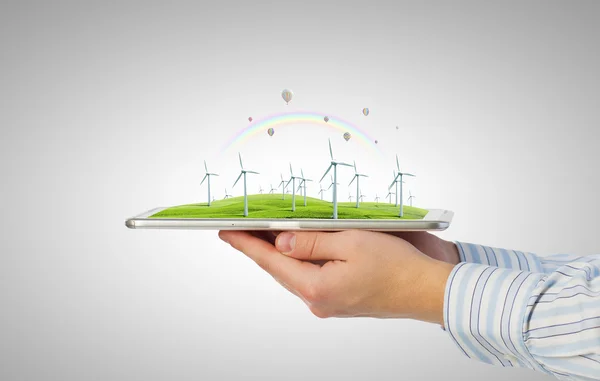Green technology is becoming a commercial necessity rather than a niche endeavor. As stakeholder demands for responsibility and climate concerns grow, businesses are using eco-innovation to lessen their environmental footprint and boost long-term performance. However, what is green technology exactly? It encompasses any technology that reduces environmental damage and promotes sustainability, such as low-waste manufacturing, energy-efficient structures, renewable energy systems, and sustainable materials.
Adopting green technology involves more than just following environmental laws. It provides quantifiable advantages, such as long-term durability, improved brand image, cost savings, and investment appeal. Businesses that incorporate eco-friendly practices gain a competitive edge as more consumers place a higher priority on sustainability. This blog examines the fundamental ideas of green technology, practical inventions, difficulties businesses encounter, and the tactical benefits of going green. Adopting green technology can help businesses of all sizes achieve both financial and environmental success.
Understanding the Core Principles of Green Technology
Fundamentally, green technology aims to lessen adverse effects on the environment while fostering long-term, steady economic growth. Its core tenets include resource conservation, pollution avoidance, energy efficiency, and product lifecycle responsibility. Green technology promotes designs that enable reuse, recycling, or biodegradable breakdown and gives priority to renewable resources over limited ones.
Systems thinking, or taking into account a product or process’s environmental impact from birth to death, is a crucial component of green technology. Building insulation composed of recycled materials, for instance, reuses waste and lowers energy use. Applications that adhere to green tech principles include biodegradable packaging, low-emission automobiles, and water-saving fixtures.
These guidelines have an impact on operations as well as product development. Businesses who are dedicated to sustainability include them into all of their decisions, from package design to supply chain sourcing. Businesses may satisfy the increasing demand for ethical solutions and match their models with global environmental goals by adhering to these fundamental principles.

Renewable Energy Innovation: Powering a Sustainable Future
Renewable energy is one of the most well-known kind of green technology. The use of geothermal, hydro, wind, and solar energy has completely changed how companies run their operations. Renewable energy sources provide long-term environmental and financial advantages over fossil fuels since they emit little or no greenhouse gases.
In an effort to lower their carbon footprint and improve their ESG reputation, many businesses are switching to sustainable energy. Google, for example, has pledged to run entirely on carbon-free electricity by 2030. In a similar vein, IKEA uses wind and solar energy to power its shops on several continents. These programs demonstrate how green energy is evolving into the norm rather than only a fad.
Renewable vs Traditional Energy for Businesses
| Feature | Renewable Energy | Traditional Energy |
|---|---|---|
| Emissions | Near zero | High CO₂ output |
| Cost (long-term) | Lower (after setup) | Fluctuating, rising |
| Resource availability | Infinite (sun, wind) | Finite (oil, coal) |
| Public perception | Highly positive | Increasingly negative |
Energy-Efficient Infrastructure: Smart Buildings & Sustainable Design
Businesses’ energy requirements increase as they expand. However, by investing in intelligent, energy-efficient infrastructure, contemporary businesses are reducing energy waste. LED lighting, motion sensors, thermal insulation, and intelligent HVAC systems that optimize power use based on real-time data are examples of this application of green technology.
Both new construction and retrofits are increasingly utilizing green building certifications such as LEED and BREEAM. Businesses are installing energy-saving and employee-wellbeing-enhancing devices in their offices, factories, and warehouses. Energy-monitoring dashboards, automatic shading systems, and smart thermostats let managers keep tabs on use and cut down on waste.
For instance, Apple Park, the company’s headquarters, is a zero-energy structure that runs entirely on renewable energy. Other businesses are encouraged by this approach to consider infrastructure as a strategic asset when preparing for sustainability. Businesses may improve long-term asset value, cut emissions, and provide healthier working conditions for their employees by integrating green technology into their infrastructure.
Sustainable Manufacturing: Greener Production for a Cleaner Planet
Although manufacturing is essential to contemporary economies, it also contributes significantly to emissions and waste. Thankfully, green technology is revolutionizing the manufacturing process by offering solutions that lower pollution, energy use, and material use all along the way.
Sustainable manufacturing places a strong emphasis on waste reduction, ethical labor, eco-design, and efficient energy usage. Cleaner technologies are being used by businesses, such as automation systems that optimize resource inputs, 3D printing to decrease material waste, and waterless dyeing in textiles. Additionally, businesses are adopting the circular economy by creating items that can be disassembled and reused and by utilizing recycled materials.
Leading companies in this field include Unilever and HP. Reusable packaging initiatives by Unilever lessen reliance on plastic, whereas HP’s printers are constructed from plastic that ends up in the ocean. By implementing green technology in their production processes, businesses reduce their environmental effect and satisfy customer demands for low-footprint, ethical products, setting themselves up for long-term success in a market that is driven by sustainability.
Real-World Business Examples of Green Technology in Action
Green technology is already being used by several multinational corporations to spur innovation and enhance operations. Strong lessons on how eco-innovation may help the environment and the bottom line can be learned from these instances.
Highlights of the Case Study:
- Tesla: With its electric cars, solar energy systems, and battery storage, Tesla is transforming the auto business.
- Google: Reduces power requirements by up to 40% by optimizing data center energy utilization using AI.
- Unilever: Uses responsible sourcing and green refrigeration to cut greenhouse gas emissions across its supply chain.
- Patagonia: Encourages environmental action and runs all of its facilities in the United States entirely on renewable energy.
- Interface: A carpet company that uses closed-loop recycling and sustainable materials with the goal of becoming carbon-negative by 2040.
These companies demonstrate the viability and profitability of green technology. By using it, businesses lower risk, improve their reputation, and win over environmentally sensitive investors and customers.
Challenges and How to Overcome Them
Adopting green technology has challenges despite its advantages. Common obstacles include lack of expertise, cost, and infrastructural constraints. High upfront costs or doubts about return on investment frequently cause small enterprises to pause. Larger businesses, meanwhile, can have trouble moving outdated systems.
However, strategic planning can help you overcome these obstacles:
- Government incentives: A lot of nations provide grants and tax exemptions for environmentally friendly improvements.
- Working together with professionals: To put affordable solutions into place, cooperate with advisors or green tech suppliers.
- Phased adoption: Before making more significant expenditures, start with energy audits and minor adjustments like LED lighting or smart thermostats.
- Employee education: To guarantee effective adoption, teach employees about green practices.
Making the transition to green technology is a process. Businesses may achieve long-term savings and establish themselves as sustainability leaders by tackling these issues head-on.

Long-Term Benefits and ESG Alignment
Green technology integration has quantifiable long-term advantages. Taking sustainability seriously increases investor confidence, brand trust, operational efficiency, and cost savings. Crucially, eco-innovation assists companies in meeting Environmental, Social, and Governance (ESG) criteria, which are currently a key criterion in the investment industry.
ESG-aligned businesses are outperforming their competitors, gaining more financing, and retaining more customers. Sustainability standards are also being tightened by governments and international organizations, such as the EU and the UN. Businesses that incorporate green technology into their main strategy avoid reputational and compliance issues.
Benefits of Green Technology Adoption:
- Cost reduction through energy and resource efficiency
- Improved employee morale in green-certified spaces
- Higher customer retention through ethical branding
- Easier access to ESG-aligned investment funds
- Better risk management in an eco-regulated world
Conclusion: Green Technology is the Future of Business
Green technology integration is now a need for modern enterprises, not just a progressive gesture. Green technology is changing businesses all around the world, from smart infrastructure and ethical operations to sustainable manufacturing and renewable energy. Companies that adopt these technologies are aligning with investor interests, legal requirements, and customer values in addition to future-proofing their operations.
Indeed, there are difficulties, but they are surpassed in the long run by the advantages of efficiency, robustness, and brand integrity. Green technology will be the driving force behind the global economy’s transition to decarbonization and climate responsibility. Businesses create a brighter future for people and the environment in addition to profit by investing in sustainable solutions now. The message is unmistakable: go green or risk falling behind.








